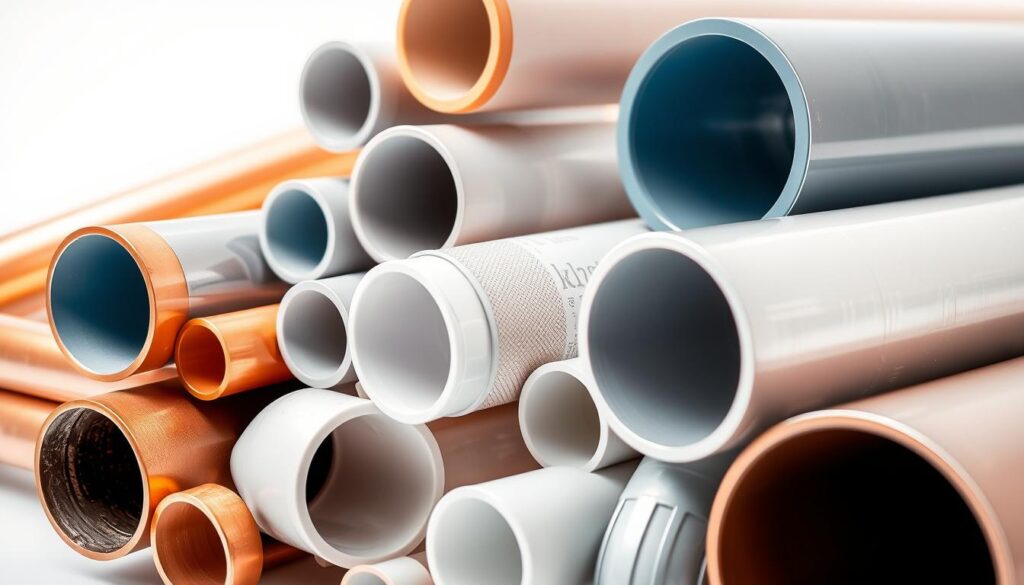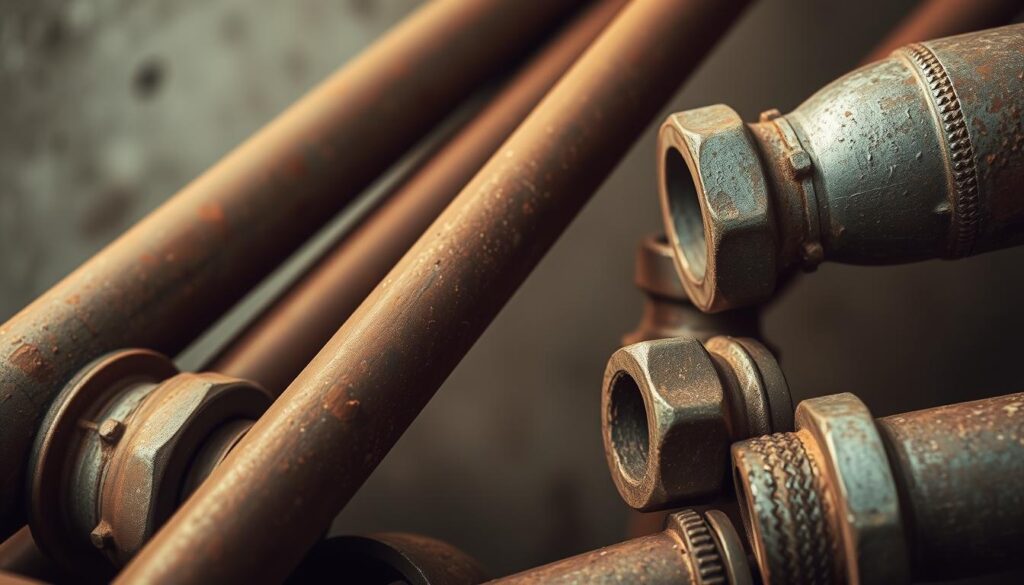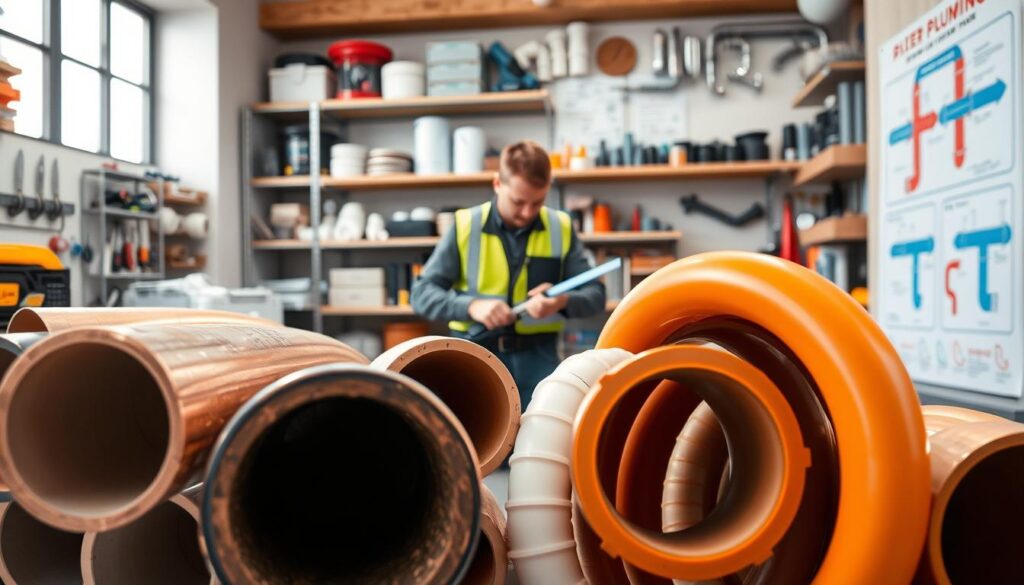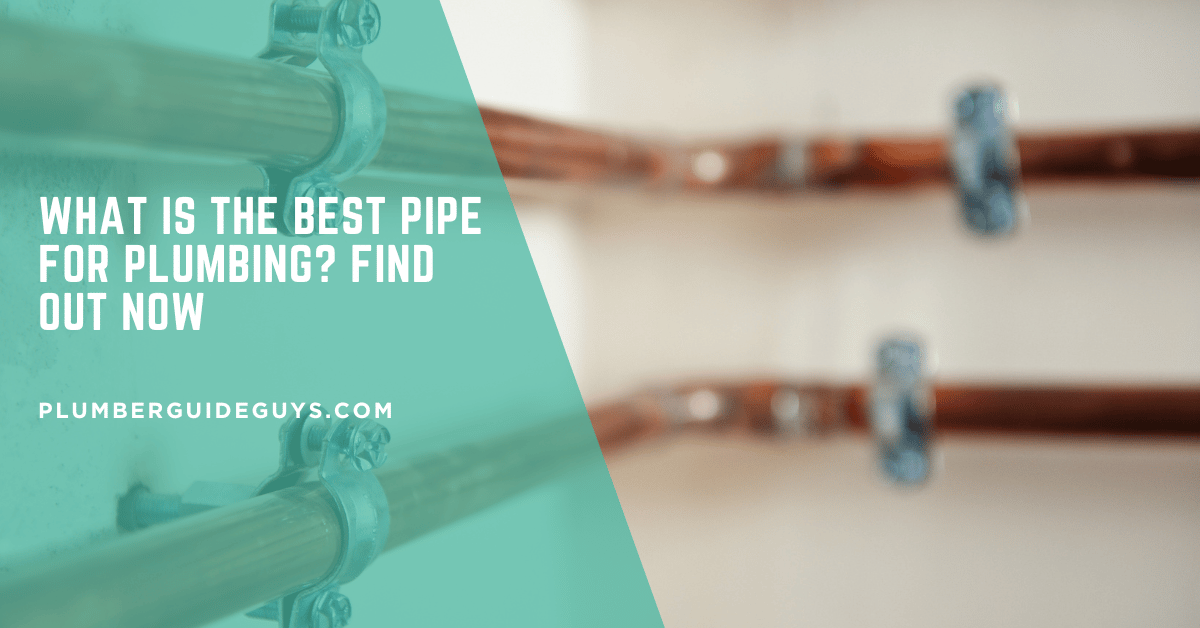Affiliate Disclosure
Plumber Guide Guys is a participant in the Amazon Services LLC Associates Program, an affiliate advertising program designed to provide a means for sites to earn advertising fees by advertising and linking to Amazon.
What is the Best Pipe for Plumbing? Did you know the average American home has over 300 feet of plumbing pipes? Choosing the right pipe can save you thousands. There’s no one pipe that fits all.

Plumbing pipe materials have changed a lot over the years. Today, homeowners have many options that didn’t exist before. Your needs, budget, and local codes will help pick the best pipe for your home.
It’s important to know how different pipes compare. Each pipe works best in different situations, like indoor water or outdoor drainage. Whether updating an old home or building new, the right pipe ensures your plumbing lasts and works well.
Key Takeaways
- Pipe selection depends on specific home requirements
- Multiple pipe materials exist for different applications
- Cost, durability, and installation complexity vary by material
- Local building codes impact pipe material choices
- Professional consultation can help determine best pipe type
Understanding Modern Plumbing Pipe Materials
Choosing the right pipe material is key for a reliable plumbing system at home. Today, we have many durable pipe types to pick from. This is thanks to years of progress in plumbing technology.
Evolution of Plumbing Materials
Plumbing has changed a lot over the years. We’ve moved from old metal pipes to new synthetic materials. Now, we have many options for pipes that meet different needs in our homes.
- Traditional metal pipes (copper, galvanized steel)
- Modern plastic alternatives (PVC, CPVC, PEX)
- Specialized composite materials
Importance of Choosing the Right Pipe Material
The pipe you choose affects water quality, how long it lasts, and upkeep costs. Each material has its own benefits, depending on what you need.
| Pipe Material | Durability | Cost Range | Best Use |
|---|---|---|---|
| Copper | 50-70 years | High | Indoor water lines |
| PEX | 40-50 years | Low | Flexible installations |
| PVC | 25-40 years | Low | Drainage systems |
Factors Affecting Pipe Selection
When picking a pipe, think about these important things:
- Water pressure needs
- Temperature changes
- Local building rules
- How much you can spend
- The specific place you’re installing it
Experts say it’s smart to think about your home’s special needs before choosing a pipe.
What is the Best Pipe for Plumbing: A Comprehensive Guide
Choosing the right pipe material is key for your home’s plumbing. The best pipe can greatly affect your plumbing’s performance and cost over time. Knowing your options helps you pick the best for your needs.
Modern homes use several main pipe materials, each with its own traits:
- Polyvinyl Chloride (PVC)
- Cross-linked Polyethylene (PEX)
- Copper
- Acrylonitrile Butadiene Styrene (ABS)
- Cast Iron and Galvanized Steel
When looking for durable pipes, consider several factors. These include how long the pipe lasts, how hard it is to install, and its cost. Your home’s needs and local building rules will help you choose the right pipe.
Choosing the right pipe material is not just about immediate needs, but about ensuring reliable water distribution for years to come.
Each pipe material has its own benefits. PVC pipes are lightweight and don’t corrode, while copper is very durable. PEX is popular for its flexibility and easy setup. The right material depends on your plumbing project.
Experts say to think about your home’s needs before deciding. Things like water pressure, temperature changes, and environmental factors are important. They help pick the best pipe material.
Copper Pipes: The Traditional Choice
Copper is a top choice for plumbing in homes and businesses. Homeowners have chosen copper pipes for years. They love their durability and how well they perform compared to other pipes.
Copper pipes stand out in the debate against PVC. They come in different types, making them flexible for various needs.
Types of Copper Piping
- Rigid Copper: Best for long, straight runs
- Flexible Copper: Ideal for tight spaces and complex routing
Durability and Lifespan
Copper pipes can last up to 50 years or more with the right installation. They resist corrosion and handle high water pressure well. This makes them stronger than many other materials.
Cost Considerations
Copper pipes cost more at first than plastic ones. But, their long life and reliability make them a good investment. Many plumbers suggest using copper for its proven performance in homes.
PVC and CPVC Pipes: Versatile Plastic Solutions
PVC and CPVC are top picks for plumbing needs. They are light and cost-effective, making them great for homes and businesses. These plastics are better than metal pipes in many ways.
PVC pipes have many benefits:
- They are very affordable
- They resist chemical damage
- They are light and simple to install
- Perfect for carrying cold water
CPVC pipes take PVC’s good points further. They can handle both hot and cold water. This makes them very useful for different plumbing tasks.
Here’s what sets PVC and CPVC apart:
| Feature | PVC | CPVC |
|---|---|---|
| Temperature Range | Cold Water Only | Hot and Cold Water |
| Cost | Lower | Slightly Higher |
| Chemical Composition | Standard Chlorine | Additional Chlorine Treatment |
Think about what you need for your plumbing project. PVC is good for drain lines and cold water. CPVC is better for a full water system.
Professional tip: Always check local building codes to ensure compliance when using PVC or CPVC pipes in your plumbing system.
PEX Piping: The Modern Innovation
PEX piping has changed residential plumbing with its new design and benefits. It’s a cost-effective option that many plumbers and DIY fans prefer.
PEX stands out when compared to copper pipes. It’s flexible, making installation easier and reducing leaks. This makes it a great choice for today’s plumbing systems.
Remarkable Installation Benefits
- Extremely flexible and easy to maneuver around obstacles
- Requires fewer connections compared to rigid piping
- Can be installed in tight spaces with minimal cutting
- Resistant to freezing and bursting
Superior Temperature Performance
PEX pipes handle temperatures well, perfect for both hot and cold water. They can handle very cold and very hot temperatures without breaking.
“PEX piping represents the next generation of plumbing technology, with unmatched flexibility and durability.” – Plumbing Innovations Magazine
Unmatched Cost-Effectiveness
PEX is also good for your wallet. It costs less than copper and is easier to install. This saves money on materials and labor.
PEX piping is changing the plumbing world. It offers great performance, flexibility, and value. Homeowners get a reliable, modern solution for their water needs.
Cast Iron and Galvanized Steel: Legacy Materials
Cast iron and galvanized steel are interesting legacy materials in plumbing. They were key in home plumbing for many years. These materials were chosen for their lasting qualities, making them popular in the early to mid-20th century.

Cast iron pipes were known for their strength and ability to reduce noise. They were built to last, with benefits like:
- Exceptional durability lasting up to 100 years
- Superior sound dampening capabilities
- Excellent heat resistance
- Substantial structural integrity
Galvanized steel pipes were used for water distribution. They were coated with zinc to protect against corrosion, but they had problems later on.
“Understanding the history of plumbing materials helps homeowners make informed decisions about pipe maintenance and replacement.”
Today, plumbers know that these materials have their challenges. Issues like corrosion, lead contamination, and reduced water flow can affect them. If you find these pipes in old homes, getting a professional check is important for safe water.
Even though cast iron and galvanized steel were great in their time, newer plumbing technologies are better. They solve the problems of older materials.
Comparing Pipe Materials for Different Applications
Choosing the right plumbing pipe materials is important. Each application has its own needs. The right water line materials depend on these needs.
When picking the best pipe for water lines, consider a few key things. These factors affect how well the pipe works and lasts.
Indoor Plumbing Requirements
Indoor pipes need to handle steady water pressure and changing temperatures. Your choice should consider:
- Water supply line durability
- Resistance to corrosion
- Ease of installation
- Cost-effectiveness
Outdoor and Underground Usage
Outdoor pipes must withstand harsh weather. Soil conditions, UV exposure, and temperature changes are key to choosing the right material.
| Pipe Material | Outdoor Performance | Underground Suitability |
|---|---|---|
| PEX | Good flexibility | Excellent resistance |
| Copper | Limited UV protection | Moderate performance |
| PVC | Moderate durability | Good underground use |
Temperature Considerations
Temperature affects pipe performance. Some pipes work better with hot water, others with cold. Knowing this helps you choose the right pipe for your needs.
Choosing the right pipe material isn’t just about cost—it’s about long-term performance and reliability.
Installation and Maintenance Considerations

Choosing the right pipe for your home’s plumbing is important. It affects how well your water system works over time. Think about how easy it is to install and maintain different types of pipes.
When you’re planning to install plumbing, keep these points in mind:
- Ease of installation and required technical skills
- Specific tools needed for pipe fitting
- Compatibility with existing plumbing infrastructure
- Local building code requirements
Different materials need different ways to be installed. PEX pipes, for example, are easier to install than copper or PVC. How complex the installation is can affect your project’s cost and time.
Keeping your plumbing system in good shape is also key. Each type of pipe has its own maintenance needs:
- Copper pipes need regular checks for corrosion
- PVC pipes should avoid direct sunlight
- PEX pipes should watch out for UV damage
- Cast iron pipes might need special care to avoid scaling
Spending time on proper installation and regular upkeep can make your plumbing last longer. This ensures your home gets reliable water.
“The right installation today prevents costly repairs tomorrow.”
Cost Analysis of Different Plumbing Materials
Choosing the right plumbing pipes is about looking at both the upfront and long-term costs. The type of pipes you pick can greatly affect your home’s upkeep costs and how well it works.
When we look at copper vs pvc plumbing pipes, several important financial points come up:
- Initial material costs
- Installation expenses
- Long-term maintenance needs
- Durability and when you might need to replace them
PVC and PEX pipes are often the most affordable choices. They cost less upfront and are easier to install. They’re also lighter, which means less labor and simpler repairs.
“Smart homeowners understand that the cheapest option isn’t always the most economical in the long run.” – Plumbing Industry Expert
Copper pipes, though pricier, last a long time. Their higher initial cost is balanced by their long-lasting performance. Homeowners might pay more at first but save on future replacements.
| Pipe Material | Average Cost per Linear Foot | Estimated Lifespan |
|---|---|---|
| PVC | $0.50 – $1.00 | 25-40 years |
| Copper | $2.00 – $4.00 | 50-70 years |
| PEX | $0.40 – $2.00 | 40-50 years |
Your specific plumbing needs will decide the best choice for you. Think about water quality, your local climate, and your home’s special needs when you make your choice.
Conclusion
Choosing the best pipe for plumbing needs careful thought. Each material has its own strengths and weaknesses. Your choice depends on your budget, where you live, the water quality, and how you plan to use it.
Remember, no pipe is perfect for every job. Copper is durable, PEX is flexible, and PVC is affordable. Your local building codes and the environment also play a big role in your choice.
Getting advice from experts is key. Home Depot suggests talking to licensed plumbers. They know the rules and what your home needs. Make sure the materials work well together and are easy to maintain.
By considering all these factors, you can pick the right pipe for your project. Focus on quality, reliability, and following the rules. This way, you’ll avoid problems later on.
FAQ
What is the best type of pipe for home plumbing?
How long do different plumbing pipes typically last?
What are the most cost-effective plumbing pipes?
What is the best type of pipe for home plumbing?
How long do different plumbing pipes typically last?
What are the most cost-effective plumbing pipes?
FAQ
What is the best type of pipe for home plumbing?
There’s no single “best” pipe for all situations. The ideal pipe depends on your specific needs. This includes water pressure, temperature, local building codes, and budget. PEX, copper, and PVC are popular options.
PEX offers flexibility and ease of installation. Copper provides durability. PVC is cost-effective for many applications.
How long do different plumbing pipes typically last?
Pipe lifespan varies by material. Copper pipes can last 50-70 years. PEX pipes typically last 40-50 years.
PVC pipes have a 25-40 year lifespan. Galvanized steel pipes may last 20-50 years. Proper installation and maintenance can extend pipe life.
What are the most cost-effective plumbing pipes?
PVC and PEX are generally the most cost-effective options. PVC pipes are inexpensive and easy to install, costing
FAQ
What is the best type of pipe for home plumbing?
There’s no single “best” pipe for all situations. The ideal pipe depends on your specific needs. This includes water pressure, temperature, local building codes, and budget. PEX, copper, and PVC are popular options.
PEX offers flexibility and ease of installation. Copper provides durability. PVC is cost-effective for many applications.
How long do different plumbing pipes typically last?
Pipe lifespan varies by material. Copper pipes can last 50-70 years. PEX pipes typically last 40-50 years.
PVC pipes have a 25-40 year lifespan. Galvanized steel pipes may last 20-50 years. Proper installation and maintenance can extend pipe life.
What are the most cost-effective plumbing pipes?
PVC and PEX are generally the most cost-effective options. PVC pipes are inexpensive and easy to install, costing $0.50-$1 per linear foot.
PEX pipes are slightly more expensive at $1-$3 per linear foot. They offer greater flexibility and easier installation compared to copper, which can cost $2-$4 per linear foot.
Can I mix different types of pipes in my plumbing system?
While it’s possible to connect different pipe materials, you’ll need appropriate connectors and transition fittings. Always consult a professional plumber to ensure proper connections.
Proper connections meet local building codes and prevent leaks or compatibility issues.
Are there any health concerns with different plumbing pipe materials?
Some materials have specific considerations. Copper is naturally antimicrobial. PEX is BPA-free. PVC can potentially leach chemicals at high temperatures.
Copper pipes are often considered the safest option for drinking water. Modern alternatives like PEX have been extensively tested for safety.
Which pipe material is best for hot water lines?
Copper and PEX are typically the best choices for hot water lines. Copper has excellent heat resistance and durability. PEX can handle high temperatures and is more flexible.
Avoid using PVC for hot water, as it can deform or degrade at high temperatures.
What factors should I consider when choosing plumbing pipes?
Consider water pressure, temperature requirements, local building codes, cost, durability, ease of installation, and specific application needs. Each pipe material has unique strengths.
Evaluate your specific plumbing requirements before making a final decision.
Are there environmental considerations for different pipe materials?
PEX and PVC are less environmentally friendly due to their plastic composition. Copper is more recyclable but requires more energy to produce. Some newer PEX pipes are being manufactured with more sustainable processes.
FAQ
What is the best type of pipe for home plumbing?
There’s no single “best” pipe for all situations. The ideal pipe depends on your specific needs. This includes water pressure, temperature, local building codes, and budget. PEX, copper, and PVC are popular options.
PEX offers flexibility and ease of installation. Copper provides durability. PVC is cost-effective for many applications.
How long do different plumbing pipes typically last?
Pipe lifespan varies by material. Copper pipes can last 50-70 years. PEX pipes typically last 40-50 years.
PVC pipes have a 25-40 year lifespan. Galvanized steel pipes may last 20-50 years. Proper installation and maintenance can extend pipe life.
What are the most cost-effective plumbing pipes?
PVC and PEX are generally the most cost-effective options. PVC pipes are inexpensive and easy to install, costing
FAQ
What is the best type of pipe for home plumbing?
There’s no single “best” pipe for all situations. The ideal pipe depends on your specific needs. This includes water pressure, temperature, local building codes, and budget. PEX, copper, and PVC are popular options.
PEX offers flexibility and ease of installation. Copper provides durability. PVC is cost-effective for many applications.
How long do different plumbing pipes typically last?
Pipe lifespan varies by material. Copper pipes can last 50-70 years. PEX pipes typically last 40-50 years.
PVC pipes have a 25-40 year lifespan. Galvanized steel pipes may last 20-50 years. Proper installation and maintenance can extend pipe life.
What are the most cost-effective plumbing pipes?
PVC and PEX are generally the most cost-effective options. PVC pipes are inexpensive and easy to install, costing $0.50-$1 per linear foot.
PEX pipes are slightly more expensive at $1-$3 per linear foot. They offer greater flexibility and easier installation compared to copper, which can cost $2-$4 per linear foot.
Can I mix different types of pipes in my plumbing system?
While it’s possible to connect different pipe materials, you’ll need appropriate connectors and transition fittings. Always consult a professional plumber to ensure proper connections.
Proper connections meet local building codes and prevent leaks or compatibility issues.
Are there any health concerns with different plumbing pipe materials?
Some materials have specific considerations. Copper is naturally antimicrobial. PEX is BPA-free. PVC can potentially leach chemicals at high temperatures.
Copper pipes are often considered the safest option for drinking water. Modern alternatives like PEX have been extensively tested for safety.
Which pipe material is best for hot water lines?
Copper and PEX are typically the best choices for hot water lines. Copper has excellent heat resistance and durability. PEX can handle high temperatures and is more flexible.
Avoid using PVC for hot water, as it can deform or degrade at high temperatures.
What factors should I consider when choosing plumbing pipes?
Consider water pressure, temperature requirements, local building codes, cost, durability, ease of installation, and specific application needs. Each pipe material has unique strengths.
Evaluate your specific plumbing requirements before making a final decision.
Are there environmental considerations for different pipe materials?
PEX and PVC are less environmentally friendly due to their plastic composition. Copper is more recyclable but requires more energy to produce. Some newer PEX pipes are being manufactured with more sustainable processes.
FAQ
What is the best type of pipe for home plumbing?
There’s no single “best” pipe for all situations. The ideal pipe depends on your specific needs. This includes water pressure, temperature, local building codes, and budget. PEX, copper, and PVC are popular options.
PEX offers flexibility and ease of installation. Copper provides durability. PVC is cost-effective for many applications.
How long do different plumbing pipes typically last?
Pipe lifespan varies by material. Copper pipes can last 50-70 years. PEX pipes typically last 40-50 years.
PVC pipes have a 25-40 year lifespan. Galvanized steel pipes may last 20-50 years. Proper installation and maintenance can extend pipe life.
What are the most cost-effective plumbing pipes?
PVC and PEX are generally the most cost-effective options. PVC pipes are inexpensive and easy to install, costing
FAQ
What is the best type of pipe for home plumbing?
There’s no single “best” pipe for all situations. The ideal pipe depends on your specific needs. This includes water pressure, temperature, local building codes, and budget. PEX, copper, and PVC are popular options.
PEX offers flexibility and ease of installation. Copper provides durability. PVC is cost-effective for many applications.
How long do different plumbing pipes typically last?
Pipe lifespan varies by material. Copper pipes can last 50-70 years. PEX pipes typically last 40-50 years.
PVC pipes have a 25-40 year lifespan. Galvanized steel pipes may last 20-50 years. Proper installation and maintenance can extend pipe life.
What are the most cost-effective plumbing pipes?
PVC and PEX are generally the most cost-effective options. PVC pipes are inexpensive and easy to install, costing $0.50-$1 per linear foot.
PEX pipes are slightly more expensive at $1-$3 per linear foot. They offer greater flexibility and easier installation compared to copper, which can cost $2-$4 per linear foot.
Can I mix different types of pipes in my plumbing system?
While it’s possible to connect different pipe materials, you’ll need appropriate connectors and transition fittings. Always consult a professional plumber to ensure proper connections.
Proper connections meet local building codes and prevent leaks or compatibility issues.
Are there any health concerns with different plumbing pipe materials?
Some materials have specific considerations. Copper is naturally antimicrobial. PEX is BPA-free. PVC can potentially leach chemicals at high temperatures.
Copper pipes are often considered the safest option for drinking water. Modern alternatives like PEX have been extensively tested for safety.
Which pipe material is best for hot water lines?
Copper and PEX are typically the best choices for hot water lines. Copper has excellent heat resistance and durability. PEX can handle high temperatures and is more flexible.
Avoid using PVC for hot water, as it can deform or degrade at high temperatures.
What factors should I consider when choosing plumbing pipes?
Consider water pressure, temperature requirements, local building codes, cost, durability, ease of installation, and specific application needs. Each pipe material has unique strengths.
Evaluate your specific plumbing requirements before making a final decision.
Are there environmental considerations for different pipe materials?
PEX and PVC are less environmentally friendly due to their plastic composition. Copper is more recyclable but requires more energy to produce. Some newer PEX pipes are being manufactured with more sustainable processes.
Can I mix different types of pipes in my plumbing system?
Are there any health concerns with different plumbing pipe materials?
Which pipe material is best for hot water lines?
What factors should I consider when choosing plumbing pipes?
Are there environmental considerations for different pipe materials?
.50-
FAQ
What is the best type of pipe for home plumbing?
There’s no single “best” pipe for all situations. The ideal pipe depends on your specific needs. This includes water pressure, temperature, local building codes, and budget. PEX, copper, and PVC are popular options.
PEX offers flexibility and ease of installation. Copper provides durability. PVC is cost-effective for many applications.
How long do different plumbing pipes typically last?
Pipe lifespan varies by material. Copper pipes can last 50-70 years. PEX pipes typically last 40-50 years.
PVC pipes have a 25-40 year lifespan. Galvanized steel pipes may last 20-50 years. Proper installation and maintenance can extend pipe life.
What are the most cost-effective plumbing pipes?
PVC and PEX are generally the most cost-effective options. PVC pipes are inexpensive and easy to install, costing $0.50-$1 per linear foot.
PEX pipes are slightly more expensive at $1-$3 per linear foot. They offer greater flexibility and easier installation compared to copper, which can cost $2-$4 per linear foot.
Can I mix different types of pipes in my plumbing system?
While it’s possible to connect different pipe materials, you’ll need appropriate connectors and transition fittings. Always consult a professional plumber to ensure proper connections.
Proper connections meet local building codes and prevent leaks or compatibility issues.
Are there any health concerns with different plumbing pipe materials?
Some materials have specific considerations. Copper is naturally antimicrobial. PEX is BPA-free. PVC can potentially leach chemicals at high temperatures.
Copper pipes are often considered the safest option for drinking water. Modern alternatives like PEX have been extensively tested for safety.
Which pipe material is best for hot water lines?
Copper and PEX are typically the best choices for hot water lines. Copper has excellent heat resistance and durability. PEX can handle high temperatures and is more flexible.
Avoid using PVC for hot water, as it can deform or degrade at high temperatures.
What factors should I consider when choosing plumbing pipes?
Consider water pressure, temperature requirements, local building codes, cost, durability, ease of installation, and specific application needs. Each pipe material has unique strengths.
Evaluate your specific plumbing requirements before making a final decision.
Are there environmental considerations for different pipe materials?
PEX and PVC are less environmentally friendly due to their plastic composition. Copper is more recyclable but requires more energy to produce. Some newer PEX pipes are being manufactured with more sustainable processes.
per linear foot.
PEX pipes are slightly more expensive at
FAQ
What is the best type of pipe for home plumbing?
There’s no single “best” pipe for all situations. The ideal pipe depends on your specific needs. This includes water pressure, temperature, local building codes, and budget. PEX, copper, and PVC are popular options.
PEX offers flexibility and ease of installation. Copper provides durability. PVC is cost-effective for many applications.
How long do different plumbing pipes typically last?
Pipe lifespan varies by material. Copper pipes can last 50-70 years. PEX pipes typically last 40-50 years.
PVC pipes have a 25-40 year lifespan. Galvanized steel pipes may last 20-50 years. Proper installation and maintenance can extend pipe life.
What are the most cost-effective plumbing pipes?
PVC and PEX are generally the most cost-effective options. PVC pipes are inexpensive and easy to install, costing $0.50-$1 per linear foot.
PEX pipes are slightly more expensive at $1-$3 per linear foot. They offer greater flexibility and easier installation compared to copper, which can cost $2-$4 per linear foot.
Can I mix different types of pipes in my plumbing system?
While it’s possible to connect different pipe materials, you’ll need appropriate connectors and transition fittings. Always consult a professional plumber to ensure proper connections.
Proper connections meet local building codes and prevent leaks or compatibility issues.
Are there any health concerns with different plumbing pipe materials?
Some materials have specific considerations. Copper is naturally antimicrobial. PEX is BPA-free. PVC can potentially leach chemicals at high temperatures.
Copper pipes are often considered the safest option for drinking water. Modern alternatives like PEX have been extensively tested for safety.
Which pipe material is best for hot water lines?
Copper and PEX are typically the best choices for hot water lines. Copper has excellent heat resistance and durability. PEX can handle high temperatures and is more flexible.
Avoid using PVC for hot water, as it can deform or degrade at high temperatures.
What factors should I consider when choosing plumbing pipes?
Consider water pressure, temperature requirements, local building codes, cost, durability, ease of installation, and specific application needs. Each pipe material has unique strengths.
Evaluate your specific plumbing requirements before making a final decision.
Are there environmental considerations for different pipe materials?
PEX and PVC are less environmentally friendly due to their plastic composition. Copper is more recyclable but requires more energy to produce. Some newer PEX pipes are being manufactured with more sustainable processes.
– per linear foot. They offer greater flexibility and easier installation compared to copper, which can cost – per linear foot.
Can I mix different types of pipes in my plumbing system?
While it’s possible to connect different pipe materials, you’ll need appropriate connectors and transition fittings. Always consult a professional plumber to ensure proper connections.
Proper connections meet local building codes and prevent leaks or compatibility issues.
Are there any health concerns with different plumbing pipe materials?
Some materials have specific considerations. Copper is naturally antimicrobial. PEX is BPA-free. PVC can potentially leach chemicals at high temperatures.
Copper pipes are often considered the safest option for drinking water. Modern alternatives like PEX have been extensively tested for safety.
Which pipe material is best for hot water lines?
Copper and PEX are typically the best choices for hot water lines. Copper has excellent heat resistance and durability. PEX can handle high temperatures and is more flexible.
Avoid using PVC for hot water, as it can deform or degrade at high temperatures.
What factors should I consider when choosing plumbing pipes?
Consider water pressure, temperature requirements, local building codes, cost, durability, ease of installation, and specific application needs. Each pipe material has unique strengths.
Evaluate your specific plumbing requirements before making a final decision.
Are there environmental considerations for different pipe materials?
PEX and PVC are less environmentally friendly due to their plastic composition. Copper is more recyclable but requires more energy to produce. Some newer PEX pipes are being manufactured with more sustainable processes.

